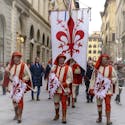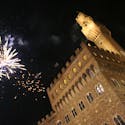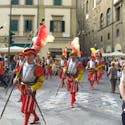A one-on-one exclusive interview with Fabrizio Valleri, a "portatore di palla" for the Bianchi of Santo Spirito
Summer in Tuscany is full of interesting, and quite unique, local events. Siena has got its Palio and Florence has its Calcio Storico Fiorentino. Aside from this, they are in no way comparable to each other.
In Siena, the Palio affects everyone, the entire city. It affects the life of its citizens from the time they are born until their death. They are baptized into their neighborhood contrada, daily life revolves around winning a Palio each summer which in turn affects how the rest of the year turns out. Whether there is celebration or mourning, it takes over the entire community. Since it involves horses, racing them around the main piazza, it is also believing that plain Luck is on your side since which horse you get is the luck of the draw a few days before each race.
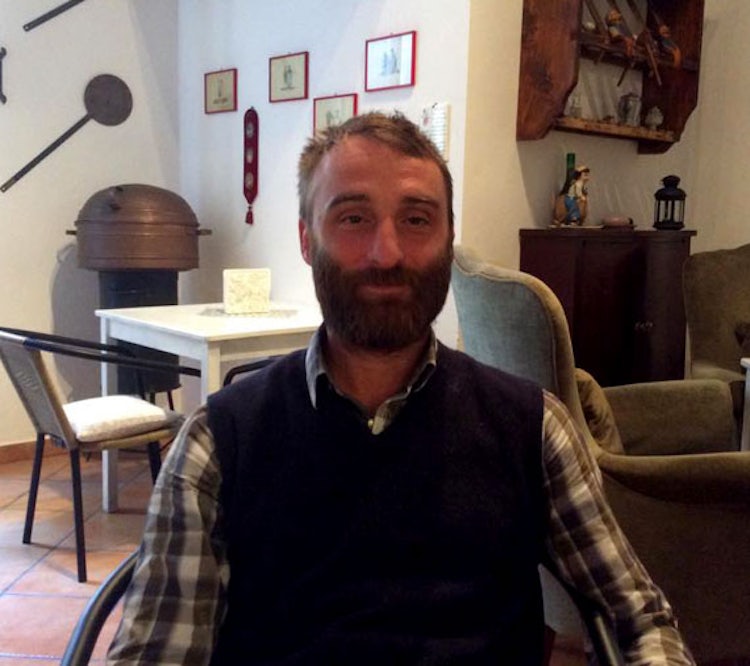
Fabrizio on any usual day hides away the tough "calciante" demeaner and actually seemed a bit shy
In Florence, the Calcio Storico has been marginalized as far as local life goes. As least this is Fabrizio Valleri's impression, a calciante for the White team from Santo Spirito. The Calcio and life around it deeply affects the few and their family and friends who directly participate, but sadly, no longer takes over the city or over all of its citizens. While it is not an event put on solely for the benefit of tourists, it seems that the number of locals that the game is important to has been diminishing over time which might mean one day it might simply end.
I sincerely hope not, but these are some of the thoughts Fabrizio, a man who never envisioned himself as a "calciante" for Calcio Storico but who now plays an important role in his team, seems to believe influence the future of the Calcio Storico in Florence. While the Palio in Siena is a city-wide event, in Florence the Calcio has created a small community, also smaller than just the city center. Even within the historical center, it does not affect all of its citizens alike, as most continue on without even knowing who won the final match (which is always played on June 24th, on the city's patron saint's feast day - read more about events on that day here). It involves human beings, men who go out to battle against each other and who know their physical prowess and team interaction will directly affect who wins.
I was lucky to sit down with Fabrizio, also known as "Il Vallero", since he is one of his team's "tiratori" and quite popular. Because he's lean and agile, his offensive role has him run and snake between opponents and team members alike on the field score the "caccia", or points, at the far end of the piazza. Wanting to get an insider's look into the life of a Calcio player and what the game is, I asked him more about what he does, why he does it and what Calcio Storico means to him. [Update June 2015: Fabrizio went on to score many caccia weeks after this interview and led his team to victory in this year's finals! Congrats to the Whites!!]
What is Calcio Storico, what do you want "outsiders" to know about the game?
The base is this: it is the historical re-enactment of a match played on February 17, 1530 when the Republic of Florence was under siege by the Imperial forces of Charles V. It was how citizens decided to show they didn't care for the Imperial forces beyond the walls, that the many months of siege was not having the effect they were hoping for.
Keep in mind that a game where a ball being thrown around was played long before then, but after the siege was over and the Medici came back into town, the "calcio" was taken over by local nobility and rules were imposed. The game was generally played in the winter, but stopped by the Grand Dukes of Tuscany in the early 18th century. The "original" teams were Whites and Greens.
Today's game came back in 1930 in the shape of a tournament that celebrates that game played during the siege, when Florence was of the citizens and a republic. That is when the city was divided into 4 colors for parts of the city: the "Bianchi" (Whites) of Santo Spirito, the "Azzurri" (Blues) of Santa Croce, the "Rossi" (Reds) of Santa Maria Novella and the "Verdi" (Greens) of San Giovanni. For this reason, it is played in costume but the original games were played in winter, back in February so that made more sense. Now the tournament is played in June, in honor of St. John the Baptist, and we wouldn't survive in the heat so most of us now play in costume only as far as the pants go, with a t-shirt sometimes, but definitely not in full costume.
For this reason, the team is like a military squadron: there is a captain who carries a sword and a standard bearer, then the rest are the troops. This is where the "violence" in the game comes from: consider we are men fighting over the ball who can defend it with physical contact and "energetic" fights, "conquering" territory following military techniques and strategy. We don't have real metal weapons, just our bodies so those are the weapons we can use to attain our goal.
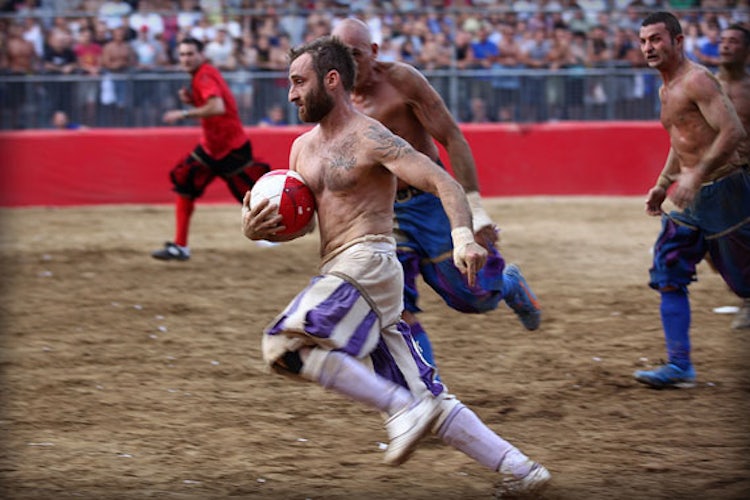
Here is Fabrizio "Vallero" as he runs with the ball - Photo credit Franco Ciarleglio
It seems quite violent, are there any rules?
Yes, it is a violent game as anything goes and there are no rules except for one: respect for the adversary. It is the ancient code of honor, chivalry. This means respect for the adversary, which means not taking advantage if the adversary is on the ground or coming up from behind. After that, there are no rules - you can hit, kick, tackle and run, of course!
You break that rule, you can get disqualified for years. There are other rules imposed by politicians to try to make the game more attractive for spectators, to curb some of the violence. But the origins and essence of the game is violence, so those rules are not part of what Calcio is for Florence.
Where does the violence come in into a game of ball?
It is a way to distract members of the other team, but of course, it is a chance to work out pent up anger and frustrations that have accumulated over the year as well.
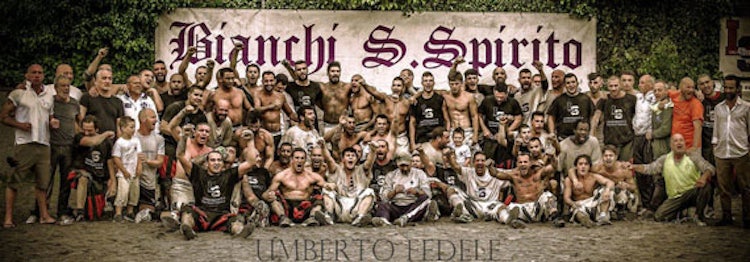
The Bianchi of Santo Spirito - Photo credit Umberto Fedele
Who can play in Calcio Storico?
Anyone who lives in these areas who wants to play can try out - if they have skills to play and can train, they can become part of the team.
The only "problem" we have is that there are hardly any remaining residents within these areas in the center. So the teams have expanded into the surrounding residential areas and neighborhoods closest to their area, with only my team, the Bianchi, still having most of its members be local residents in the Oltrarno (although we also have team members from Scandicci). The Azzurri have expanded into Novoli and Ponte di Mezzo, the Rossi into Isolotto, the Verdi into Campo di Marte.
Can someone from outside of Florence also be part of a team?
Yes, we have some members from other parts of Italy like Rome, Ravenna and Bologna and even from England who have connections with Florence: they have to commit to show up for training, to be part of the team. If you have skills we can use and train with us, you're part of the team. It is a large community, it becomes an extended family. We have 60-70 players although only 27 are selected to play at a match. They change every year but you still create a special bond.
How long is training?
Training starts in September/October but it gets more intense in the last 3 months before the tournament. We train 3 times a week so it is a big time commitment, that's why whoever wants to be part of the team has to live here. You train with your own companions, but simulate the real games so you can get hurt. I've actually not been training the last few weeks as I got hurt and got a broken rib in early May.
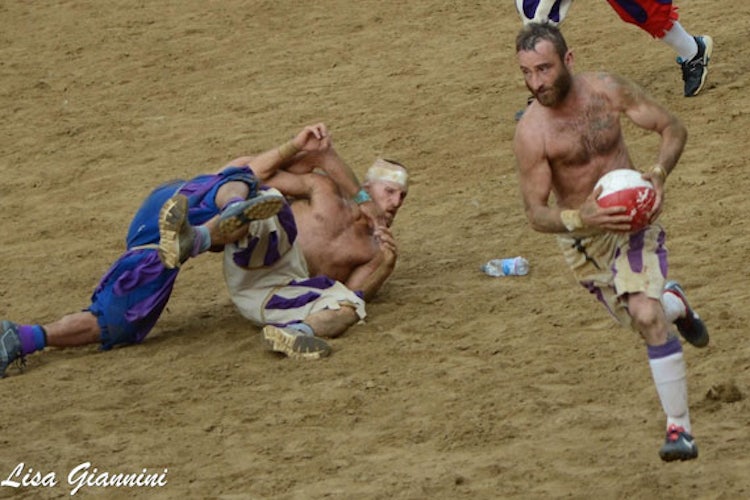
Il Vallero is very fast when he gets the ball - Photo credit Lisa Giannini
What about you, your own personal experience as a "calciante": how long have you been playing for? how did you become a part of the Bianchi?
I've been a calciante for 12 years, although we keep track more of the matches we've played in, which at most is 1-2 every year. I've played in 15-16 games. I was disqualified for a year. During these last few months prior to June, you enter into the calciante mood and that becomes your identify for this period, the rest of the year you are just a normal person.
My dad used to take me to watch training sessions in our neighborhood, in the Oltrarno, since I was 5-6 years old. I never saw myself as a calciante, they were like gods in my eyes to be worshiped. I never thought to try out, but was encouraged to do so several times and when I finally did, I found myself in a surreal world. But I could be of use to the team since I could run fast! So I'm a tiratore, my job is to grab the ball and make caccie for my team.
Of course, if you are big, heavyset and powerful, that's important too. We need those in the front lines. Even I need to train and learned to defend myself. You can use all of your limbs, so you learn boxing and wrestling techniques, some soccer and rugby as well. Anything goes. You have no protections aside from a teeth and shin guard (and jock strap, of course) so you will likely get hurt. You have to give back as much as you get. Some players on the field never even touch the ball, are just there to hit.
It seems quite violent, what happens where you're out on the field? Is it just competition between the teams?
First, there is no fear. I don't feel fear. The game puts you to the test, it challenges you. There is a lot of competition to show you are better than your adversaries but it generally isn't on a personal level, you are playing for your team, your neighborhood in your city.
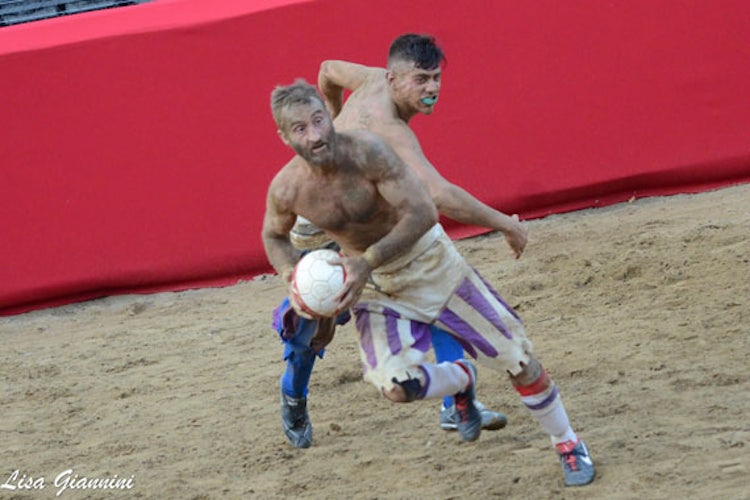
He's fast but he still suffered through a bit of tumbles - Photo credit Lisa Giannini
What to expect from the game?
Violence for sure, although not that bad. There have been several really violent games that have gone down in the books, but in general, they are not that bad.
Would you suggest kids to attend?
I have two kids, but I don't take them since I play. I think for them the experience would be different than when my father took me to watch. But yes, I think older kids can get involved by watching, understanding the game.
How long is the game?
50 minutes. Which can seem really long or really short.
Are players paid to participate?
Not at all. All voluntary. The city budgets around 12,000 euro to each of the colors, which covers everything from uniforms to training field upkeep.
The funny thing is that even if in the last few years interest from Italian and foreign media has increased, to publicize as well as broadcast the games, the city (of Florence) itself has yet to take advantage of it. Requests get turned down, there is no real press office to manage the image of the tournament beyond the city as the Palio has done in Siena. I think it is a real waste, not taking advantage but I suppose there are political forces at work here that go beyond me. Can you believe, that even if they charge for tickets, the city loses money in putting on the tournament? A percentage of the ticket cost just goes to the company who sells the tickets, what ends up to the city and to the teams/neighborhoods is nothing! It could really invest in the game, in the sense of community and use it as another way to promote the city. Last year, in 2014, the mayor deemed too many rules has been broken in the semi-finals, and for the first time ever, canceled the final game. While tickets were reimbursed, it was not a good move for the image of the Calcio or of the city for those that had looked forward to it.
Yes, it is violent and fights are part of the game. I think it should be accepted as such, rather than trying to change the rules and game because then it is no longer what Calcio is.
Is there a particular rivalry between the colors?
Yes! Between us, it with the Azzurri. This has developed over the last 30 years as they have had this winning streak over this time - but we finally won in 2012!!
It was a major cause for celebration for the entire Oltrarno area!
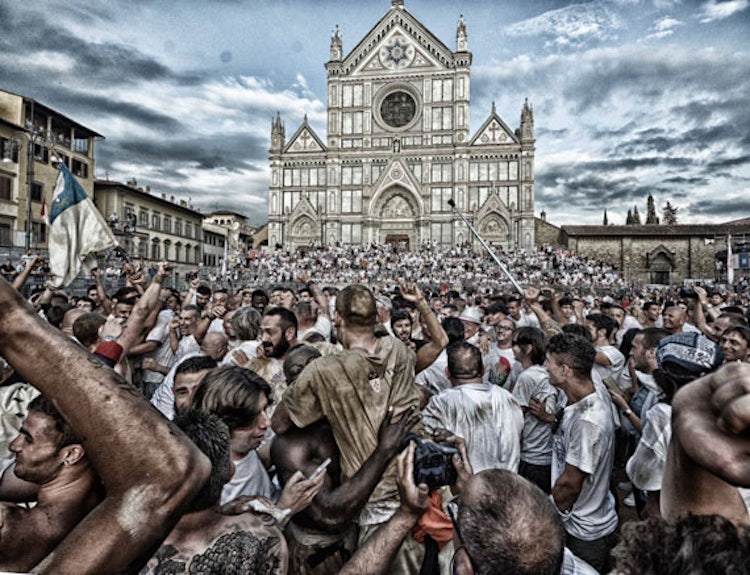
The Bianchi celebrate after their 2015 win of Calcio Storico Fiorentino - Photo credit Maurizio Rufino
What do you win?
A Palio and a Chianina ox, which used to be part of the menu in the neighborhood parties to celebrate the victory. It isn't like that anymore. We get the Palio, which is done by a local artist, but the ox is now just symbolic, rented for the day and is in the parade for show. We celebrate after with several parties!
So you said you are a normal person the rest of the year, what do you do?
I am one of three owners of a restaurant in Oltrarno called Trattoria I' Raddi, who used to belong to a calciante for the Bianchi years ago. The restaurant serves local specialities with a few contemporary twists, the chef is another co-owner, and the trattoria is a local hangout for the team and the neighborhood. I have friends in other parts of the city, who belong to the other teams, so the rest of the year we are not in battle!
I am actually in politics, I am a representative for the quartiere on the local city council but I've decided politics isn't for me. I don't intend to seek re-election.
Hypothetically, would you ever leave Florence and give Calcio Storico up?
No, I was born, raised and have lived my whole life here in Florence. I intend to die here as well, so don't ever foresee that being a possibility. I'll play for as long as I can, it is now part of my life and family, so it would be really difficult to imagine ever leaving.
My interview with Fabrizio was really interesting, particularly from a "foreigner" as myself who grew up moving as a kid and never had deep roots much anywhere. The time I've lived in Florence is now the longest I've lived anywhere, ever, and it is still a bit strange for me to imagine being in one location for an entire lifetime. I know this is the case for many people, but the long history and special monuments that Florence offers to local citizens are particularly amazing. I thank Fabrizio for his time and willingness to share this part of his Florentine life with us!!
You can also follow the Bianchi of Santo Spirito on their Facebook page.
UPDATE 25/06/2015:
The final has just been played on June 24th and Fabrizio's Bianchi of Oltrarno just won this year's final over the Verdi from San Giovanni!!
Congrats to the Bianchi and to Fabrizio, who was an important element in all of the passes that won the Bianchi the semi-final match against their rivals, the Azzurri, and brought them to the final match.
Photo credits: Lourdes Flores, Franco Ciarleglio, Lisa Giannini, Umberto Fedele, Maurizio Rufino

